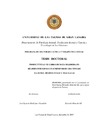Please use this identifier to cite or link to this item:
https://accedacris.ulpgc.es/jspui/handle/10553/2105
| Title: | Productividad de cabras de raza majorera en régimen intensivo con suministro de dos tipos de raciones, tradicionales y mezcladas | Authors: | Monzón Gil, Elizardo | Director: | Castañón Rodríguez, José Ignacio | UNESCO Clasification: | 310906-1 Nutrición. Rumiantes 3109 Ciencias veterinarias |
Keywords: | Cabras Alimentación |
Issue Date: | 2007 | Abstract: | En este trabajo de investigación se estudió el crecimiento y la producción láctea de un rebaño de cien cabras de raza Majorera en una explotación convencional en régimen intensivo. La alimentación de los animales estuvo basada en una mezcla de ingredientes concentrados y en el aporte de heno de ray-grass. Los animales se distribuyeron en dos lotes, uno recibió los ingredientes mezclados (ración completa mezclada, RCM) y el otro lote recibió la mezcla de concentrado separada del forraje (ración tradicional, RT).
El crecimiento de las cabritas, desde los 84 hasta los 334 días de edad (momento en que alcanzan el último tercio de la gestación) se ajustó a la regresión lineal peso (kg) = 3,52 + 0,13 x edad (días). El lote RCM ingirió 202,50 kg MS de MIC por animal y 44,4 kg MS de heno durante los 250 días del periodo de recría, mientras que el consumo de MIC por el lote RT fue 208,30 kg MS por animal y 29,6 kg MS de heno. La ganancia media de peso fue significativamente (p<0,05) diferente: 0,120 kg diarios en el lote RCM y 0,135 kg diarios en el lote RT.
La producción láctea de las cabras, hasta el décimo mes de lactación, se ajustó a la curva cuadrática producción (litros/día) = 1,47 + 0.024 x tiempo (semana de lactación) – 0.001 x tiempo2 durante la primera lactación, y a la curva exponencial producción (litros/día) = 2,08 x tiempo (semana de lactación)0,296 x e -0,051xtiempo durante la segunda lactación. En ambas lactaciones la ingestión total del lote RCM fue mayor (un 8-9% más de MIC y un 42% más de heno) que en el lote RT; en ambas lactaciones la ingestión de heno supuso un 14% de la ingesta total de MS consumida por el lote RCM, mientras que supuso un 11% de la ingestión total de MS en el lote RT. Las cabras alimentadas con la RCM tuvieron, en general, una producción significativamente mayor (p<0,05) que las cabras alimentadas con la RT, tanto en la primera como en la segunda lactación, así como un mayor contenido proteico y graso de la leche. This research studied the growth and milk production of a herd with one hundred goats belonging to Majorera race in a conventional holding with intensive management. The feeding of the animals was based on a mixture of concentrate ingredients and ryegrass hay. The animals were divided into two lots, one received mixed ingredients (complete mixed ration, RCM) and the other group received forage separated from concentrate (traditional ration, RT). The growth of kids, from 84 to 334 days old (when they reach the last third of gestation) was adjusted to the linear regression: weight (kg) = 3.52 + 0.13 x age (days). The lot RCM ingested 202.50 kg DM MIC per animal and 44.4 kg DM hay during the 250 day period of growing, while consumption of MIC for the lot RT was 208.30 kg DM per animal and 29.6 kg DM hay. The average weight gain was significantly (p<0,05) different: 0120 kg daily in the lot feeding RCM and 0135 kg daily in the lot RT. The milk production of dairy goats, until the tenth month of lactation, was adjusted to the production quadratic curve (liters/day) = 1.47 + 0.024 x time (week of lactation) – 0.001 x time2 during the first lactation, and to a production exponential curve (liters/day) = 2.08 x time (week of lactation)0.296 x e-0.051xtime during the second lactation. In both lactations ingestion total of goats feeding RCM was higher (8-9% more of MIC and a 42% more hay) than that of group RT; in both lactations the ingestion of hay was a 14% of the total intake of DM consumed by the lot RCM, while representing an 11% of the total intake of DM in the lot RT. Goats fed RCM produced, in general, significantly (p<0,05) more milk than goats fed RT, in both the first and the second lactation, as well as a higher protein and fat content of the milk |
Description: | Programa de doctorado Clínica y Terapéutica Animal | Department: | Departamento de Patología Animal, Producción Animal, Bromatología y Tecnología de Los Alimentos | Faculty: | Facultad de Veterinaria | URI: | https://accedacris.ulpgc.es/handle/10553/2105 | ISBN: | 978-84-691-5727-5 |
| Appears in Collections: | Tesis doctoral |
Page view(s)
170
checked on Jan 25, 2025
Download(s)
1,413
checked on Jan 25, 2025
Google ScholarTM
Check
Altmetric
Share
Export metadata
Items in accedaCRIS are protected by copyright, with all rights reserved, unless otherwise indicated.
